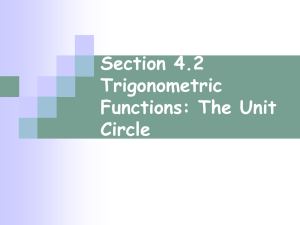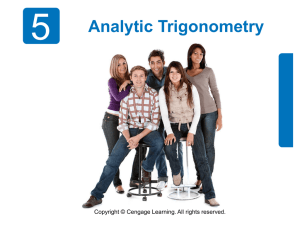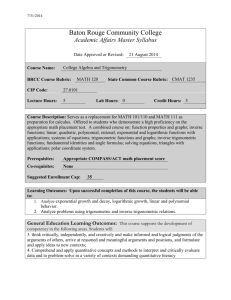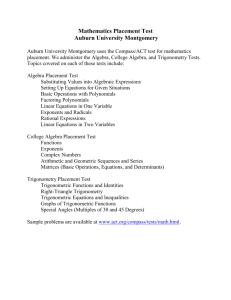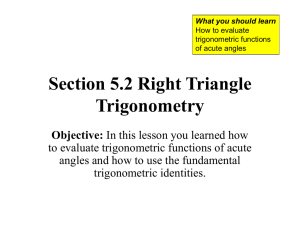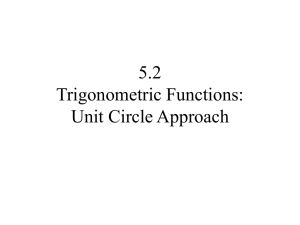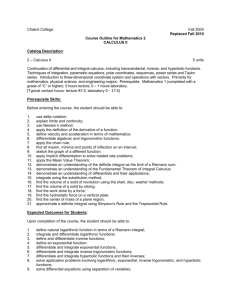Math 170 - Cuyamaca College
advertisement
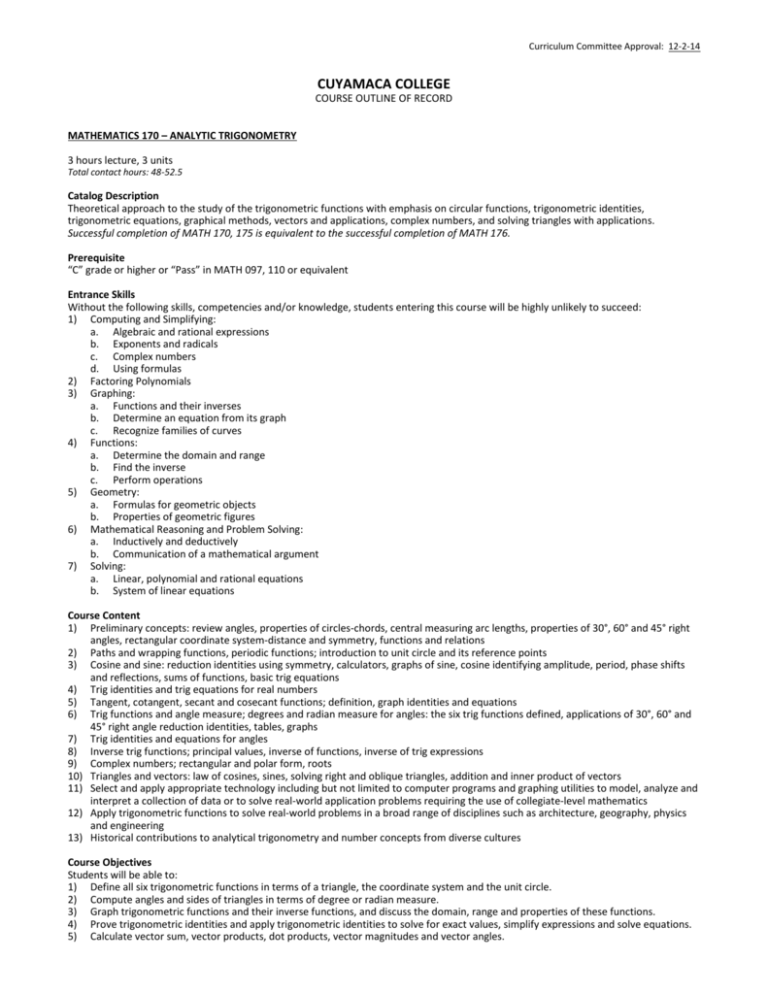
Curriculum Committee Approval: 12-2-14 CUYAMACA COLLEGE COURSE OUTLINE OF RECORD MATHEMATICS 170 – ANALYTIC TRIGONOMETRY 3 hours lecture, 3 units Total contact hours: 48-52.5 Catalog Description Theoretical approach to the study of the trigonometric functions with emphasis on circular functions, trigonometric identities, trigonometric equations, graphical methods, vectors and applications, complex numbers, and solving triangles with applications. Successful completion of MATH 170, 175 is equivalent to the successful completion of MATH 176. Prerequisite “C” grade or higher or “Pass” in MATH 097, 110 or equivalent Entrance Skills Without the following skills, competencies and/or knowledge, students entering this course will be highly unlikely to succeed: 1) Computing and Simplifying: a. Algebraic and rational expressions b. Exponents and radicals c. Complex numbers d. Using formulas 2) Factoring Polynomials 3) Graphing: a. Functions and their inverses b. Determine an equation from its graph c. Recognize families of curves 4) Functions: a. Determine the domain and range b. Find the inverse c. Perform operations 5) Geometry: a. Formulas for geometric objects b. Properties of geometric figures 6) Mathematical Reasoning and Problem Solving: a. Inductively and deductively b. Communication of a mathematical argument 7) Solving: a. Linear, polynomial and rational equations b. System of linear equations Course Content 1) Preliminary concepts: review angles, properties of circles-chords, central measuring arc lengths, properties of 30°, 60° and 45° right angles, rectangular coordinate system-distance and symmetry, functions and relations 2) Paths and wrapping functions, periodic functions; introduction to unit circle and its reference points 3) Cosine and sine: reduction identities using symmetry, calculators, graphs of sine, cosine identifying amplitude, period, phase shifts and reflections, sums of functions, basic trig equations 4) Trig identities and trig equations for real numbers 5) Tangent, cotangent, secant and cosecant functions; definition, graph identities and equations 6) Trig functions and angle measure; degrees and radian measure for angles: the six trig functions defined, applications of 30°, 60° and 45° right angle reduction identities, tables, graphs 7) Trig identities and equations for angles 8) Inverse trig functions; principal values, inverse of functions, inverse of trig expressions 9) Complex numbers; rectangular and polar form, roots 10) Triangles and vectors: law of cosines, sines, solving right and oblique triangles, addition and inner product of vectors 11) Select and apply appropriate technology including but not limited to computer programs and graphing utilities to model, analyze and interpret a collection of data or to solve real-world application problems requiring the use of collegiate-level mathematics 12) Apply trigonometric functions to solve real-world problems in a broad range of disciplines such as architecture, geography, physics and engineering 13) Historical contributions to analytical trigonometry and number concepts from diverse cultures Course Objectives Students will be able to: 1) Define all six trigonometric functions in terms of a triangle, the coordinate system and the unit circle. 2) Compute angles and sides of triangles in terms of degree or radian measure. 3) Graph trigonometric functions and their inverse functions, and discuss the domain, range and properties of these functions. 4) Prove trigonometric identities and apply trigonometric identities to solve for exact values, simplify expressions and solve equations. 5) Calculate vector sum, vector products, dot products, vector magnitudes and vector angles. MATH 170 6) Page 2 of 3 Analyze physical problems and create trigonometric relationships involving triangles, the coordinate system, the unit circle or vectors. Method of Evaluation A grading system will be established by the instructor and implemented uniformly. Grades will be based on demonstrated proficiency in subject matter determined by multiple measurements for evaluation, one of which must be essay exams, skills demonstration or, where appropriate, the symbol system. 1) Exploration activities (both independent and group) which measure students’ ability to discover how different parameters affect the graphs of trigonometric functions, or how to combine trigonometric relationships to prove a new trigonometric identity. 2) Homework assignments which measure students’ ability to: select and evaluate trigonometric functions, make computations in degrees and radians, create graphs of trigonometric functions, transform an expression with identities, and construct a plan and carry out the plan to solve trigonometric word problems. 3) Exams, including a comprehensive final exam and quizzes which measure students’ ability to: define and calculate with all six trigonometric functions in degrees and radians, sketch graphs of trigonometric functions as well as discuss the functions’ domain and range, construct a logical sequence of transformations which verify trigonometric identities, and breakdown a physical problem into trigonometric components in order to produce a solution. Special Materials Required of Student Calculator Minimum Instructional Facilities Smart classroom with whiteboards covering three walls, graphing utility and viewscreen, overhead projector Method of Instruction 1) Lecture and discussion 2) Teamwork 3) Instructor-guided discovery 4) Computer-facilitated instruction Out-of-Class Assignments 1) Problem sets 2) Exploratory activities and/or projects 3) Reading and/or writing assignments Texts and References 1) Required (representative example): McKeague & Turner. Trigonometry. 7th edition. Cengage, 2013. 2) Supplemental (representative example): McKeague & Turner. Trigonometry Student Solutions Manual. 7th edition. Cengage, 2013. Exit Skills Students having successfully completed this course exit with the following skills, competencies and/or knowledge: 1) Understanding essential vocabulary and basic concepts related to: a. Radian and degree measure b. Trigonometric functions of any angle c. Right triangle trigonometry 2) Graphing: a. Graph trigonometric function b. Derive equations from graphs of all trigonometric functions c. Employ ideas of amplitude, period, frequency, phase shift 3) Understanding and applying function concepts of: a. Inverse trigonometric functions b. Domain and range of inverse functions c. Relating to calculator use 4) Mathematical Reasoning: a. Know the basic identities b. Verify other identities c. Solve trigonometric equations 5) Solve applications involving: a. Right and oblique triangles b. The Pythagorean Theorem c. Law of sines d. Law of cosines and vectors 6) Using Trigonometric Form of Complex Numbers Student Learning Outcomes Upon successful completion of this course, students will be able to: 1) Evaluate all six trigonometric functions using the coordinate, right triangle or unit circle definitions. 2) Use degree and radian measures to calculate unknown parts of a triangle. 3) Graph all six trigonometric functions. 4) Given a trigonometric function, find the domain, range, amplitude, period, phase shift or vertical shift (when applicable). 5) Prove trigonometric identities. 6) Apply trigonometric identities to solve for exact values. 7) Simplify trigonometric expressions. 8) Solve trigonometric equations. MATH 170 Page 3 of 3 9) Calculate vector sum, vector products, dot products, vector magnitudes and vector angles. 10) Analyze physical problems and create trigonometric relationships involving triangles, the coordinate system, the unit circle or vectors.


